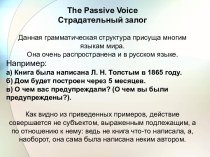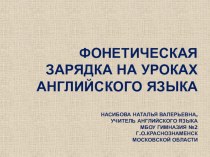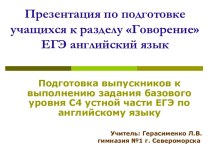- Главная
- Разное
- Бизнес и предпринимательство
- Образование
- Развлечения
- Государство
- Спорт
- Графика
- Культурология
- Еда и кулинария
- Лингвистика
- Религиоведение
- Черчение
- Физкультура
- ИЗО
- Психология
- Социология
- Английский язык
- Астрономия
- Алгебра
- Биология
- География
- Геометрия
- Детские презентации
- Информатика
- История
- Литература
- Маркетинг
- Математика
- Медицина
- Менеджмент
- Музыка
- МХК
- Немецкий язык
- ОБЖ
- Обществознание
- Окружающий мир
- Педагогика
- Русский язык
- Технология
- Физика
- Философия
- Химия
- Шаблоны, картинки для презентаций
- Экология
- Экономика
- Юриспруденция
Что такое findslide.org?
FindSlide.org - это сайт презентаций, докладов, шаблонов в формате PowerPoint.
Обратная связь
Email: Нажмите что бы посмотреть
Презентация на тему Margaret Fuller
Содержание
- 2. Sarah Margaret Fuller Ossoli, commonly known as
- 3. Born Sarah
- 4. Birthplace and childhood home of Margaret Fuller
- 5. The Greene Street School where Fuller taught from 1837 to 1839
- 6. Her seminal work, Woman in
- 7. In Fuller, Ossoli, and their child began
- 8. Fuller was an early proponent of feminism
- 9. is a book by American journalist, editor,
- 10. Woman in the
- 11. Скачать презентацию
- 12. Похожие презентации
Sarah Margaret Fuller Ossoli, commonly known as Margaret Fuller, (May 23, 1810 – July 19, 1850) was an American journalist, critic, and women's rights advocate associated with the American transcendentalism movement. She was the first full-time

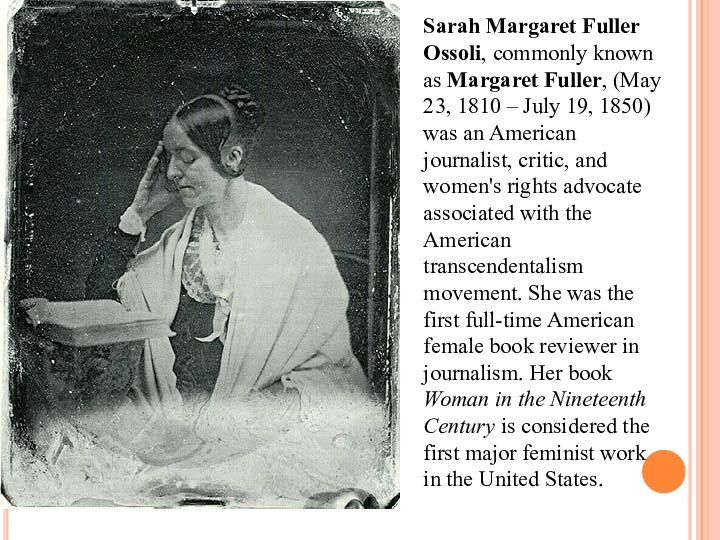
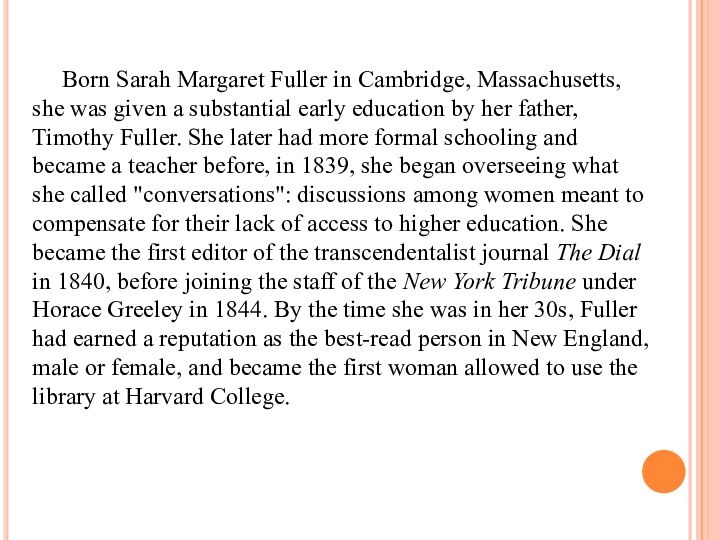



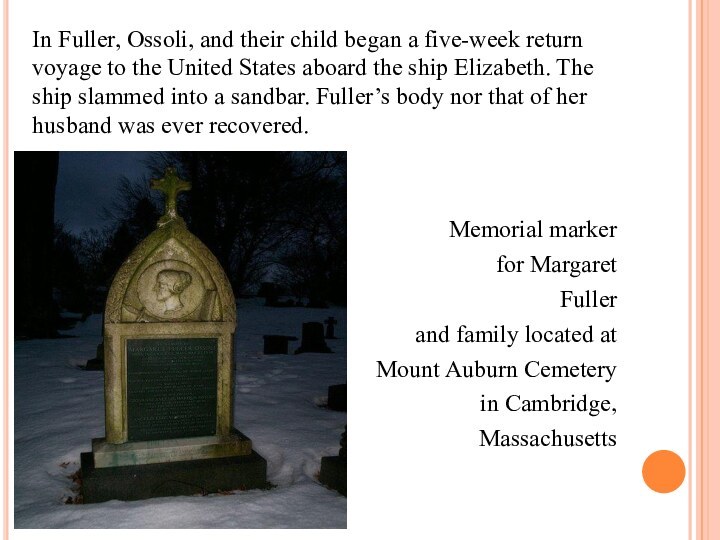
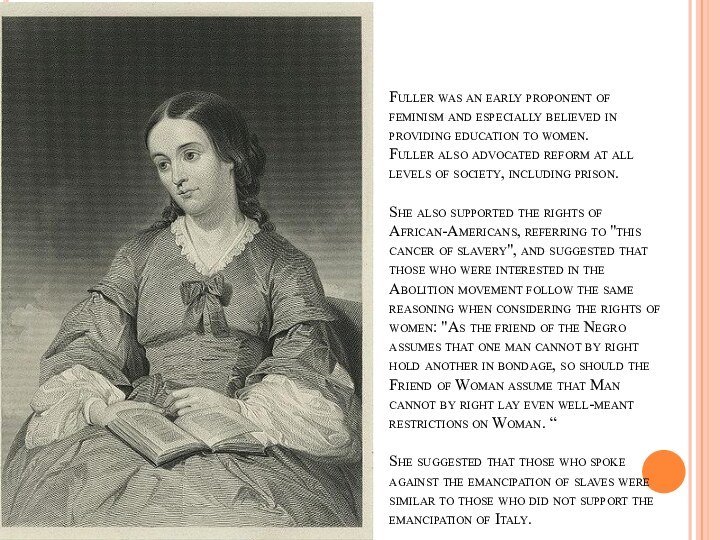
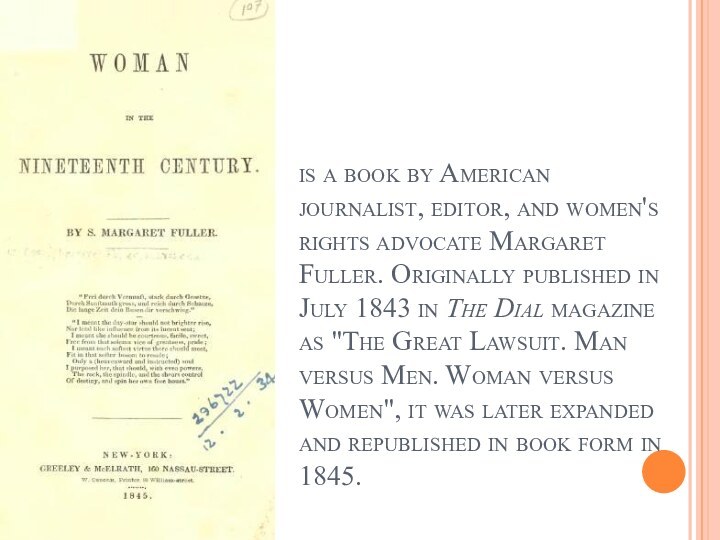
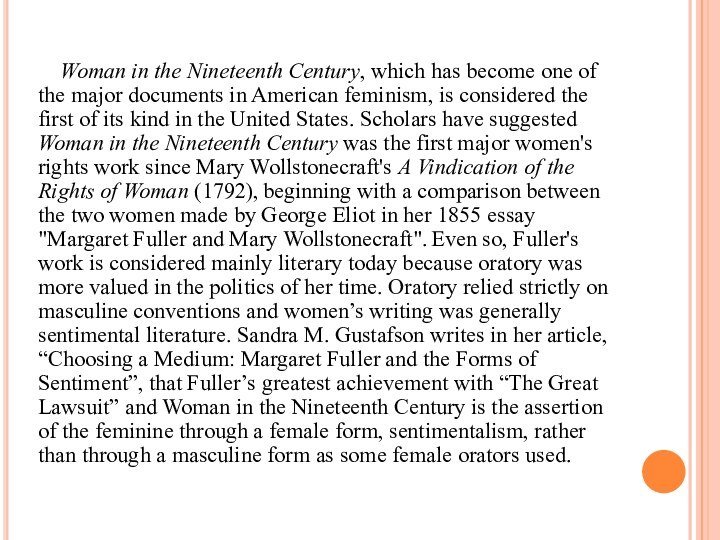

Слайд 3
Born Sarah Margaret
Fuller in Cambridge, Massachusetts, she was given a substantial
early education by her father, Timothy Fuller. She later had more formal schooling and became a teacher before, in 1839, she began overseeing what she called "conversations": discussions among women meant to compensate for their lack of access to higher education. She became the first editor of the transcendentalist journal The Dial in 1840, before joining the staff of the New York Tribune under Horace Greeley in 1844. By the time she was in her 30s, Fuller had earned a reputation as the best-read person in New England, male or female, and became the first woman allowed to use the library at Harvard College.Слайд 6 Her seminal work, Woman in the
Nineteenth Century, was published in 1845. A year later,
she was sent to Europe for the Tribune as its first female correspondent. She soon became involved with the revolutions in Italy and allied herself with Giuseppe Mazzini. She had a relationship with Giovanni Ossoli, with whom she had a child. All three members of the family died in a shipwreck off Fire Island, New York, as they were traveling to the United States in 1850. Fuller's body was never recovered.Fuller was an advocate of women's rights and, in particular, women's education and the right to employment. She also encouraged many other reforms in society, including prison reform and the emancipation of slaves in the United States. Many other advocates for women's rights and feminism, including Susan B. Anthony, cite Fuller as a source of inspiration. Many of her contemporaries, however, were not supportive, including her former friend Harriet Martineau. She said that Fuller was a talker rather than an activist. Shortly after Fuller's death, her importance faded; the editors who prepared her letters to be published, believing her fame would be short-lived, were not concerned about accuracy and censored or altered much of her work before publication.
Слайд 7 In Fuller, Ossoli, and their child began a
five-week return voyage to the United States aboard the
ship Elizabeth. The ship slammed into a sandbar. Fuller’s body nor that of her husband was ever recovered.Memorial marker
for Margaret
Fuller
and family located at
Mount Auburn Cemetery
in Cambridge,
Massachusetts







